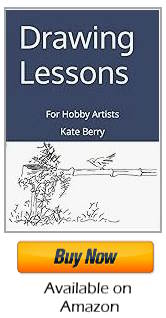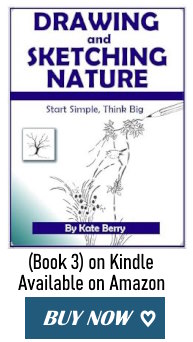Search for images or info
Tree Sketches
Tree sketches make eye-catching artwork. Not only are they enjoyable to create but nature drawings of all descriptions are very forgiving and an excellent subject for beginner artists.
Start off by sketching trees loosely or mindlessly - that's a brilliant way to help you get something on paper without worrying about having your lines exactly right. We tend to fool ourselves into thinking a tree would be a difficult subject but I urge you to experiment so you discover for yourself how easy it really is.
When you sketch, remind yourself that you want to portray a perception of your subject. Just roughly get the shape of the tree by focusing on the main branches that hold your attention and disregard the rest.
Leaves are portrayed as scribbles in the general shape of the leaf.
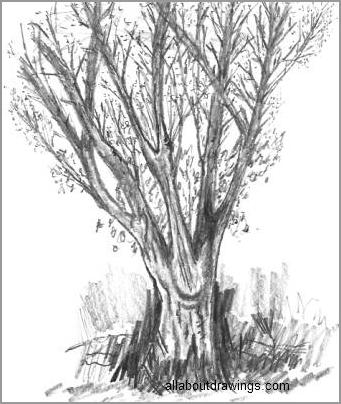
My sketch above is of a maple tree that's on the footpath across the road from my place.
I swapped between a 2B pencil and a 6B pencil for my tree sketches and I used photocopy paper which is always handy.
I drew the tree in August which is the middle of Winter here in Australia. As you can see, it is a deciduous tree and it has very little foliage.
I noted some details before I started the sketch...
- The day was overcast and quite dull so there's not much shadow.
- It was cold so my view point was from inside the house looking out a front window.
- There are still some dead leaves clinging to the bottom branches.
- The top of the tree is devoid of leaves and wispy twigs are obvious.
I finished the sketch where my view was obstructed by the top of my window. The drawing would be incorrect if I changed my viewing perspective midway. Actually, the window served as a type of frame and I think it was very helpful.
I tried to give the trunk a bit of character judging by the light and dark that I could see from across the road.
Categories
Sketches
Instruction
Freebies
Other Areas
** Disclaimer: I receive a small commission if you buy via my links -- at no extra cost to you. **
The How To Sketch Guide
Here's a book that finally dispels the mystery of sketching!
... it only takes a little instruction
or guidance... Read more >>
Sketching Guides
I noticed that I was very impatient to finish my tree sketches and that's obviously something I need to work on. I can't wait to see the finished work because it still excites me that I can draw!
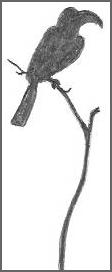
There are so many art books around and I'm always happy if I can learn something from each book.
My Mum gave me an art book called "Giovanni Civardi's Complete Guide To Drawing".
I drew my maple tree (at top of page) after practicing a method used by Giovanni.
I could have picked up any art book that I have and copied a method from it. It's a matter of what you feel like doing at the time.
It's also amazing what you learn by using a magnifying glass to clearly see the types of strokes the artist uses. Ok, admittedly my eyesight isn't as good as it used to be and maybe you don't need to do that.
However, I see lots more when I use my magnifying glass while perusing art books. I can clearly see the wonders that cross-hatching can achieve, where to blend and the difference textured paper makes.
Sketch Anything And Everything
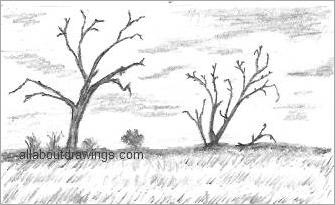
In this sketch, the trees are silhouetted against a sunset.
Sketching provides a carefree feeling. Just place your strokes where you think they belong and the sketch develops on its own.
Remind yourself that a sketch doesn't have to be perfect, so just loosen up and enjoy watching whatever appears on the paper.
Sketching is an adventure to an unknown destination -- you are bound to love it!
Producing tree sketches was fun and interesting. It looks like I might have inherited my Mum's love for landscapes.
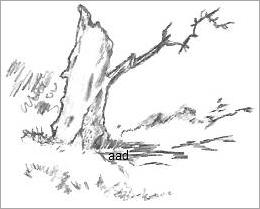
This charming old tree trunk was copied from an old book.
Whenever you find uncomplicated line drawings just like this one, pick up your pencil and copy it -- that's ultimately how you learn and progress.
You will be proud of yourself when you see your drawing is very similar to the original. Simplicity is the key.
The last sketch is a Joshua tree which is mainly found in a desert. I admire spindly plants and trees, they have so much character to offer.
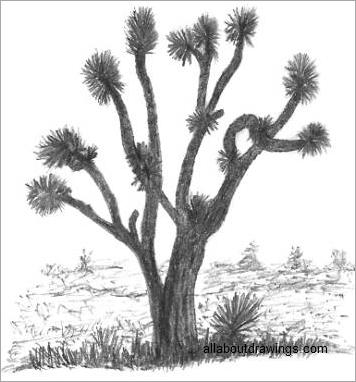
Maybe this one is more of a drawing because I became involved and lost the sketchy aspect. I did remember to sketch in the background though!
When you produce tree sketches, you come to realize that each tree is unique with its own characteristics.
Remember that you only need to portray the basic shape of the tree and its foliage. First, lightly sketch in the overall shape and observe the angles of the main branches growing out from the trunk.
Books and magazines offer great reference resources for you to go through and practice sketching trees - do this one after the other and you will surely create successful images.
For creating tree sketches outdoors, take note of your surroundings...
- From which view point do you prefer to sketch?
- Is it sunny or dull?
- Can you see any lights and darks?
- Is it windy or calm?
All of these things play a part in your drawing so make notes in your sketchpad, so you can remember the facts if you want to finish the sketch at a later date.
I never tire of looking at black and white tree sketches - for some reason, I am inexplicably drawn to them. If you also find trees visually appealing, you might also enjoy seeing some of my thumbnail drawings.
I wish you many happy drawing hours!
See the links below for a variety of sketches:
* Allaboutdrawings.com is a participant in the Amazon Services LLC Associates Program, an affiliate advertising program designed to provide a means for sites to earn advertising fees by advertising and linking to Amazon.com.
Copyright © 2005 - 2025 www.allaboutdrawings.com. All rights reserved.





